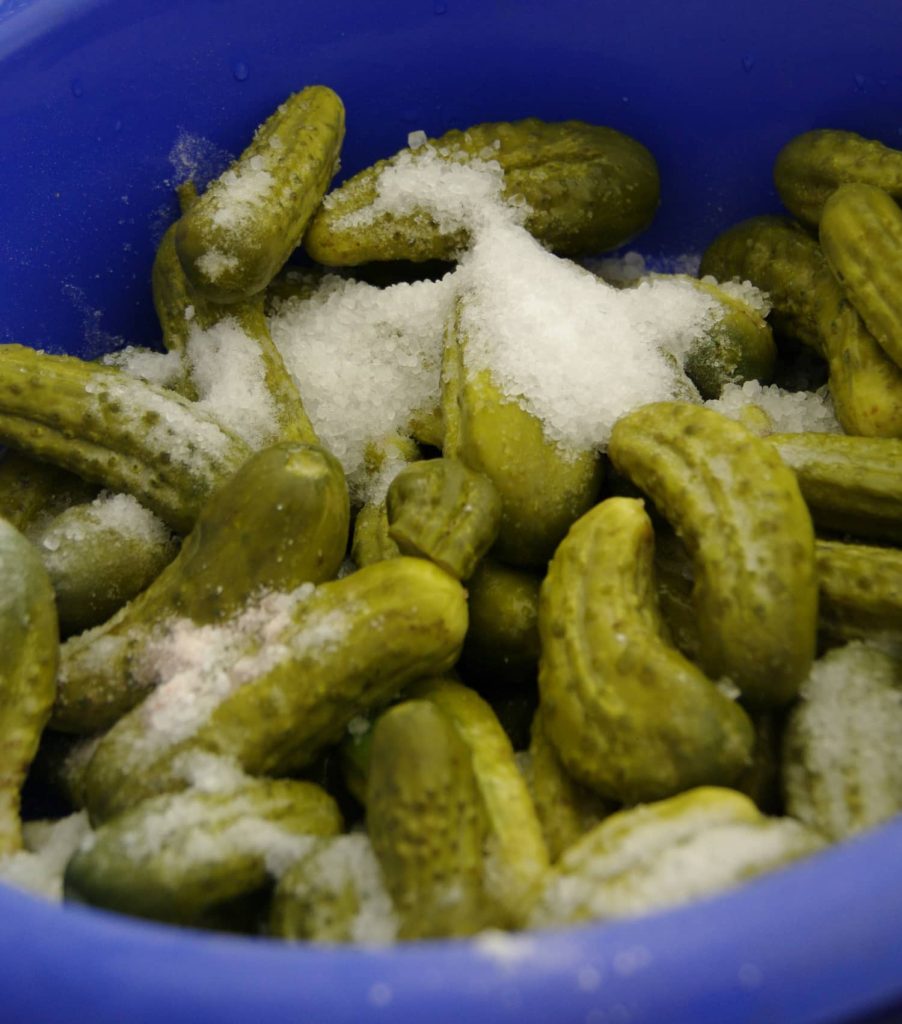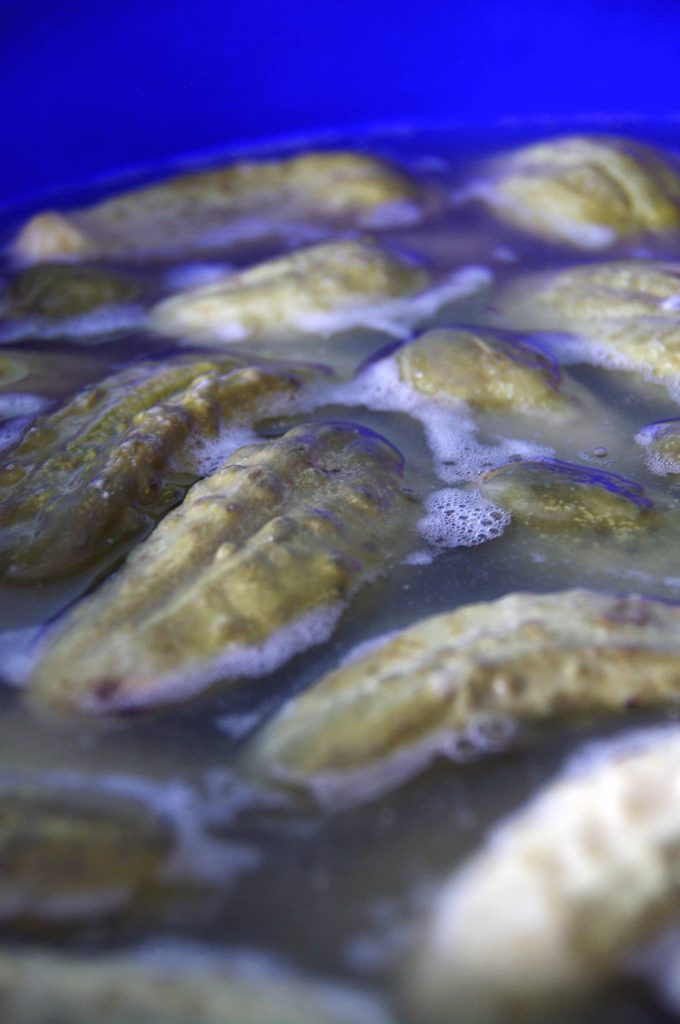
dill gherkins
I noticed gherkins at Patlin Gardens last weekend and was reminded of what a fool I made of myself entering my dill gherkins in the Tanunda Agricultural Show. Having made dill gherkins for years, without checking them, I raced a jar up to Tanunda and entered in the competition. I could have died of shame when I opened a jar to discover, instead of the usual delicious crunch absolute inedible mush. How the judges must have laughed at my presumption of entering their dill gherkin section and the judges were kind enough not to offer feedback.
A two-to-four-day process depending on the weather. Common sense is required; for example this week during the day my kitchen has been a fairly constant 26°C in other words at least 10°C above cellar temperature which is ideal. Cellar is best, but failing that, if you have a cool room [walkin–in] you can put the buckets in there and double the time required for curing or just use your fridge.
FIRST PUBLISH IN 2012 ON GALAXYGUIDES
….REVISITED 22 JANUARY 2024 AO


PICKLING MEDIUMS
Brine…CLICK HERE
Sweet–sour my Grandmother Quinn’s recipe…CLICK HERE
Essig und pfeffer [vinegar and pepper…CLICK HERE

day one
per 1.5kg gherkins
100g fine rock or sea salt
1.1g [1/4 teaspoon] pink curing salt [available from butcher suppliers]
boiling water
Wash the gherkins in cold running water and make sure all soil has been removed. Put them into a large non–corrosive container, add the salts and then cover by about 5 cm with boiling water, stir over and weight the gherkins under the water.
Leave in a cool place, stirring over a couple of times for two days.

end of day two
per
1.5kg gherkins
100g fine rock or sea salt
1.1g [1/4 teaspoon] pink curing salt [available from butcher suppliers]
boiling water
Wash the gherkins in cold running water. Put them into a large non–corrosive container, add the salts and then cover by about 5 cm with boiling water, stir over and weight the gherkins under the water. Leave in a cool place, stirring over a couple of times for two days.
Rinse the gherkins under cold running water and bottle using any of the following three styles.
tip — this curing method can also be used for cornichons, but obviously the length of the curing time is worked out relative to their size. They are then put into straight white wine vinegar with yellow mustard seeds, a few pepper corns, bay leaf.

A SMALL AMOUNT OF FIZZING IS ACCEPTABLE, HOWEVER, IF IT IS GETTING TO THIS EXTENT AND YOUR GHERKINS ARE NOT IN THE FRIDGE RUSH THEM INTO A COOLER TEMPERATURE. TOO MUCH AND YOUR GHERKINS WILL BE MUSHIE.
choose quality vinegar
Choosing a quality vinegar is vital and in Australia we only use Vine Valley White Wine Vinegar. It can be purchased in most supermarkets in 2L bottles and can be purchased wholesale in 30L drums. Other cheaper brands do not offer the same excellent flavour profile which is nicely sour and sharp without mouth wrenching acidity or chemical flavours.

brine
1kg [1L] Vine valley white wine vinegar
2kg [2L] water
100g quality fine sea or rock salt
wild fennel stalks and seed heads, chopped into about 10cm lengths
5g yellow mustard seeds [optional
]
5g whole white pepper corns [optional]
equipment
sterilised jars and lids
food service gloves
Weigh the vinegar, water and salt into a saucepan and place it on high heat. Stir until the salt is dissolved and bring to the boil. Add the herbs and spices, boil for one minute, then turn off the heat and allow to cool completely.
Use food service gloves to pack your jars and divide the pickling liquid, herb and spices between the jars and seal.
Store in a cool dark place for three weeks before using.
sweet-sour gherkins
my Grandmother Quinn’s recipe
2.4kg [2.4L] Vine Valley white wine vinegar
450g white sugar
30g whole black peppercorns
30g whole allspice
5g whole cloves [optional]
equipment
sterilised jars and lids
food service gloves
Weigh the vinegar, salt and sugar into a saucepan and place it on high heat. Add the spices, and stir long enough to bring to the boil and dissolve the sugar. When the liquid has boiled, turn off the heat and allow to cool a little.
Use food service gloves to pack your jars and divide the hot pickling liquid and spices between the jars and seal.
Store in a cool dark place for three weeks before using.
essig und pfeffer gürkens
1kg [1L] Vine Valley white wine vinegar
1kg [1L] water
20g quality sea or rock salt
20g whole black pepper, coarsely crushed
fresh or dried herbs such as tarragon or wild fennel
1 fresh bay leaf per jar
split fresh chillies optional[according to how much heat you like!
1g [1/8 teaspoon] yellow mustard seed per jar.
sterilised jars and lids
food service gloves
Pack the jars with the cured gherkins and then add pepper, herbs, bay leaf, chillies and mustard seed. Bring the vinegar water and salt to the boil and stir until the salt is dissolved. Turn off the heat and when it has cooled slightly fill the jars with the liquid and seal.
Store in a cool dark place for three weeks before using.
how much pickling liquid
How much pickling liquid to make is easy to work out. Pack your cured gherkins into sterilised jars, then fill the jars with water. Set a bowl on your scale, tare it to zero and empty the water into the bowl. Then you can work it out from the weight.
wild fennel
Wild fennel, especially if it has dried out a bit in the sun adds and excellent and authentic flavour and whilst it is abundant at the moment we don’t pick it on main roads anywhere near wild blackberries which are often spray by local councils.
adding garlic
Adding garlic can be a temperamental process and can cause problems with preserving so we give it a miss and add fresh garlic [if required] when using the gherkins.
ABOUT
We have 42 years history at the highest level
in the food and wine industry and the passion for our craft remains undiminished…
read more
ON cuisine-extreme
- People
- Kaaren Palmer Champagne
- Recipes
- News and Events
NEWSLETTER
to get the latest news, tips, and advice.